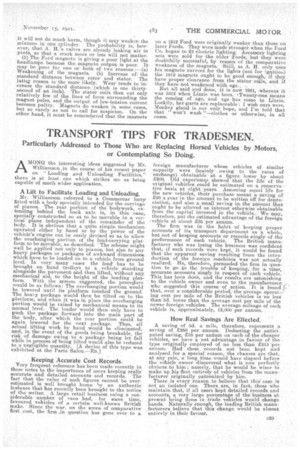TRANSPORT TIPS FOR TRADESMEN.
Page 29

If you've noticed an error in this article please click here to report it so we can fix it.
Particularly Addressed to Those Who are Replacing Horsed Vehicles by Motors, or Contemplating So Doing.
AMONG the interesting. ideas suggested by Mr. Williainson.in the course of his recent paper CU " Loading and Unloading Facilities," there is at least one which strikes me as being capable of much wider application.
A Lift to Facilitate Loading and Unloading.
Mr. Williamson referred to a Oommercar lorry fitted with a body specially intended for the carriage of pianos. The rear portion of the bodywork, extending behind the back axle is, in this ease, specially constructed so as to be movable in a vertical plane independent of the remainder of the body. It is obvious that a quite simple mechanism operated either by hand or by the power of the vehicle's engine can be easily devised so as to allow the overhanging portion of the load-carrying platform to be movable, as described. " The scheme might well be applied not only to pianos, but also to any heavy package-s. or packages of awkward dimensions which have to be loaded on to a vehicle from ground level. In very many eases the load' has to be brought on hand trolleys to a vehicle standing alongside the pavement and then lifted, without any mechanical aid, to the height of the loading platform. With the system suggested, the procedure would be as follows: The overhanging portion would be lowered until its platform touched the ground. The heaxy package would then be tilted on to the platform, and when it was in place the overhanging portion would be raised by mechanical means to its normal level. The loader would then only have to push the package forward into the main part of the body, after which the rear portion could be again lowered for the next package. Thus, all actual lifting work by hand would be eliminated, and, in the event of the goods being breakable, the risk of damage owing to a package being let fall while in process of being lifted would also be reduced to a negligible quantity. [A device of this type was exhibited at the Paris Salon.—En.)
_Keeping Accurate Cost Records.
'Very frequent reference has been made recently in these notes to the importance of users keeping really accurate and detailed accounts and records. The fact that the value of such figures cannot be overestimated is well brought home hy an authentic instance that has recently been brought to the notice of the writer. A large retail business using a considerable number of vans had, for some time, favoured vehicles of a certain well-known British make. Since the war, on the score of comparative first cost, the firm an question has gone over to a
foreign manufacturer whose vehicles of similar capacity were (mainly owing to the rates of exchange) obtainable at a figure lower by about £200. Old experieaao showed that the life of the original vehicles could be estimated on a conservative basis at eight years. Assuming equal life for the new vehicles, their purchase meant a saving of £25 a year in the amount to be written off for depreciation, and also a small saving in the amount that ought to be allowed as interest otherwise obtainable from the capital invested in the vehic.le. We may, therefore, put the estimated advantage of the foreign -vehicle at about 235 per annum.
The firm was in the habit of keeping proper accounts of its transport department as a whole, but not of keeping accounts or records eingly of the performance of each vehicle. The British manufacturer who was losing the business was confident that, if such records were kept,, it would -be found that the apparent saving resulting from the introduction of the foreign machines was not actually realized. He, therefore, persuaded the firm in question to go to the trouble of keeping, .for a time, accurate accounts singly in respect of each vehicle. This has been done, and the results are astonishing to the vehicle owner and even to the manufacturee, who suggested this course of action. It is found e that, over a considerable period, the average operat:-. ing cost per mile of the British vehicles is no lesi than 5d. lower than the average cost per mile of the newer foreign vehicles. The average mileage of each vehicle is, approximately, 12,000 per annum.
How Real Savings Are Effected.
A saving of 5d. a mile, therefore, represents a saving of £250 per annum. Deducting the antici pated saving £35 per annum on each of the cheaper vehicles, we bave a net advantage in favour of the type originally employed of no less than £215 per annum. Had these records not been kept• and analysed for a special reason, the chances are that, at any rate, a long time would have elapsed before the vehicle owner discovered what is now perfectly obvious to him ; namely, that he would be wiser to make up his fleet entirely of vehicles from the manufacturer originally patronized by him.
There is every reason to believe that this case. not not an isolated one. There, are, in fact, those who maintain that, if all users kept detailed records and accounts, a Very large pereentage of the business at present being done in trade vehicles would change hands. Naturally eneugh, the leading British manufacturers believe that this change would be almost entirely in their favour.


































